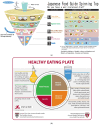Daily Amount of Purine in Commonly Recommended Well-Balanced Diets in Japan and Overseas
- PMID: 39683460
- PMCID: PMC11643512
- DOI: 10.3390/nu16234066
Daily Amount of Purine in Commonly Recommended Well-Balanced Diets in Japan and Overseas
Abstract
Background/Objectives: A low purine diet has been recommended for patients with gout and hyperuricemia, but there are concerns about excessive carbohydrates and a lack of protein. A well-balanced diet in accordance with general dietary guidelines is widely recommended. The Mediterranean diet and the DASH (Dietary Approaches to Stop Hypertension) diet are also recommended for gout and hyperuricemia patients. However, there is little information on the purine levels in these diets. The aim of this study is to determine the daily amount of purine in well-balanced diets that follows the dietary guidelines, including the Mediterranean diet and the DASH diet. Methods: We measured the purine content in various foodstuffs. Using these values, we calculated the amount of purine in generally recommended well-balanced diets-the Japanese diet, American My Plate Plan, the Mediterranean diet, and the DASH diet. To calculate the amount of purine, recipes tailored to the characteristics of each diet were created. Results: The amount of purine in the Japanese diet, in the American My Plate Plan, in the Mediterranean diet, and in the DASH diet were 308.5-366.1, 308.7-335.0, 346.6-394.1, 325.9-493.9 mg/day, respectively. These values were close to the 400 mg/day recommended in the Japanese Guideline for the management of Hyperuricemia and Gout. Conclusions: A well-balanced diet following the recommendation in the dietary guidelines is considered to provide adequate purines. Because a high purine diet can lead to the recurrence of gout, advising to eat a balanced diet is useful on lifestyle guidance for the patients with gout and hyperuricemia.
Keywords: DASH diet; Mediterranean diet; amount of purine; food guidelines; gout and hyperuricemia; well-balanced diet.
Conflict of interest statement
Author Keito Tsuruga was employed by the company FORALL Co., Ltd. The remaining authors declare that the research was conducted in the absence of any commercial or financial relationships that could be construed as a potential conflict of interest.
Figures





Similar articles
-
Determination of total purine and purine base content of 80 food products to aid nutritional therapy for gout and hyperuricemia.Nucleosides Nucleotides Nucleic Acids. 2020;39(10-12):1449-1457. doi: 10.1080/15257770.2020.1748197. Epub 2020 Apr 20. Nucleosides Nucleotides Nucleic Acids. 2020. PMID: 32312146
-
Total purine and purine base content of common foodstuffs for facilitating nutritional therapy for gout and hyperuricemia.Biol Pharm Bull. 2014;37(5):709-21. doi: 10.1248/bpb.b13-00967. Epub 2014 Feb 20. Biol Pharm Bull. 2014. PMID: 24553148 Review.
-
Dietary Interventions for Gout and Effect on Cardiovascular Risk Factors: A Systematic Review.Nutrients. 2019 Dec 4;11(12):2955. doi: 10.3390/nu11122955. Nutrients. 2019. PMID: 31817107 Free PMC article.
-
Dietary and Lifestyle-Centered Approach in Gout Care and Prevention.Curr Rheumatol Rep. 2021 Jul 1;23(7):51. doi: 10.1007/s11926-021-01020-y. Curr Rheumatol Rep. 2021. PMID: 34196878 Free PMC article. Review.
-
The role of diet in hyperuricemia and gout.Curr Opin Rheumatol. 2021 Mar 1;33(2):135-144. doi: 10.1097/BOR.0000000000000779. Curr Opin Rheumatol. 2021. PMID: 33399399 Free PMC article. Review.
References
-
- Basic Survey on National Life, Japanese Ministry of Health, Labor and Welfare Website. 2022. [(accessed on 22 November 2024)]. Available online: https://www.mhlw.go.jp/toukei/saikin/hw/k-tyosa/k-tyosa22/index.html.
-
- Hisatome I., Ichida K., Mineo I., Ohtahara A., Ogino K., Kuwabara M., Ishizaka N., Uchida S., Kurajoh M., Kohagura K., et al. Guidelines for Management of Hyperuricemia and Gout 3rd edition. Gout Uric Nucleic Acids. 2020;44((Suppl. S1)):1–40.
MeSH terms
Substances
LinkOut - more resources
Full Text Sources
Medical

